As we enter June we near the end of the first half of a year rich in invention and creativity, as gateways the world over unveil pioneering projects designed to help travellers make the most of their time at the airport and improve the overall passenger experience. Here, Airport Business outlines its Top 10 airport innovations of the year so far.
10. Cork Airport introduces real-time flight tracking
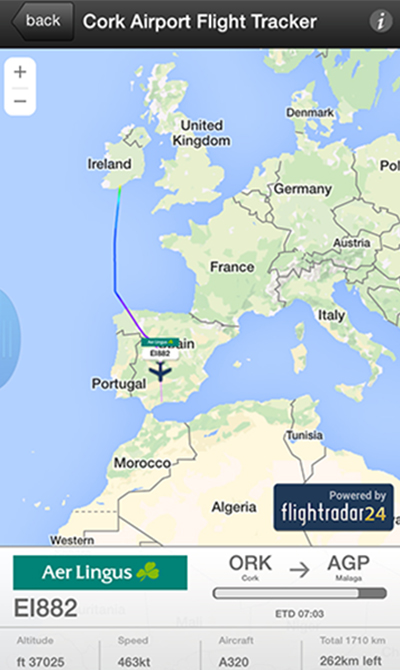 In January of this year, Cork Airport became the first gateway to partner with revolutionary flight tracking service Flightradar24 to provide real-time flight tracking via its airport app. The innovative feature enabled travellers to view detailed information on the Irish airport’s departing and arriving flights by clicking on an aircraft on the in-app map, through which users can discover an aircraft’s route, speed, type, altitude, distance travelled and total distance to its destination.
In January of this year, Cork Airport became the first gateway to partner with revolutionary flight tracking service Flightradar24 to provide real-time flight tracking via its airport app. The innovative feature enabled travellers to view detailed information on the Irish airport’s departing and arriving flights by clicking on an aircraft on the in-app map, through which users can discover an aircraft’s route, speed, type, altitude, distance travelled and total distance to its destination.
Kevin Cullinane, Head of Communications at Cork Airport, commented at the time: “We are delighted to launch the new flight scanning feature on our app. To be the first airport in the world to introduce this innovative feature is a fantastic achievement and is a further example of Cork Airport’s commitment to providing a world-class customer experience for every passenger using the airport.”
Back in 2014 the forward-thinking gateway became the first in Ireland to enable passengers to view detailed, three-dimensional maps of all public areas of the airport with the integration of Google Indoor Street View within the Cork Airport App. “We will continue to innovate and introduce new initiatives to maintain the world-class customer experience for which we are known,” Cullinane said.
9. Helsinki Airport’s naturally beautiful baggage hall
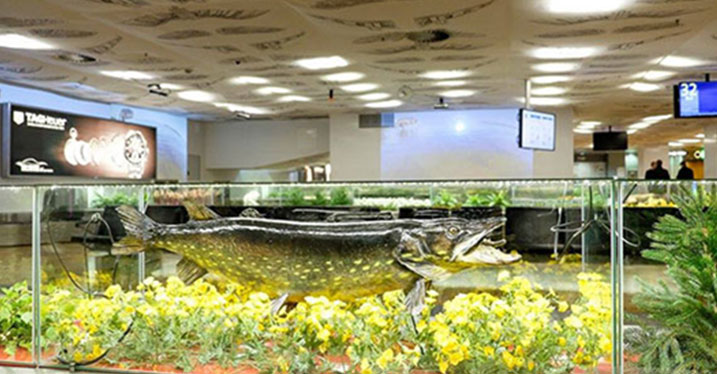
In a captivating demonstration of its commitment to creating an extraordinary experience for its passengers, Helsinki Airport in January unveiled its new-look baggage hall, designed to reflect Finland’s spectacular natural beauty, and give the airport real sense-of-place. The Exit 2B baggage lobby was redesigned by internationally acclaimed interior architect and sculptor Stefan Lindfors, who has worked alongside Finavia, the operator of Helsinki Airport, on a number of other projects in recent years.
Glass-encased showcases portraying Finnish plants and wildlife were placed in between the baggage claim belts, while live footage of Finnish nature is now being projected on one of the walls. The ceiling, meanwhile, was covered with fabric representing wings, and the walls decorated with a circuit board pattern, which was hand-drawn by Lindfors and pays homage to Finnish IT expertise. “Many airports are very similar in style, whether you are in the Nordic countries, Central Europe or the United States,” Lindfors explained. “I want all of my work to really stand out from the others. I want passengers arriving in the lobby to experience something unique and to feel that they have just arrived in Finland.”
Ville Haapasaari, Director of Helsinki Airport, added: “Helsinki Airport is Finland’s business card and for many passengers the first contact with Finland. That is why it is important that we stand out from other airports in a surprising way. A memorable arrival lobby will leave a positive impression on a passenger and that might make the passenger travel via Helsinki Airport also the next time.”
8. Tigerair Australia rolls out iPads to empower agents and reduce queues
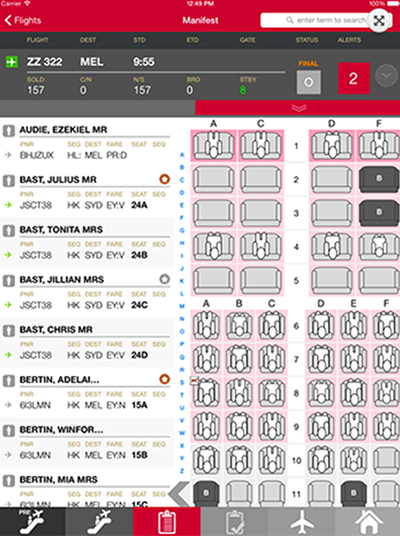 Last month Tigerair Australia began equipping its airport agents with iPads, in a move that allows staff to roam around the terminal and check-in passengers away from the traditional check-in desk. The iPads, which have the ‘MAX Airport by Levarti’ app installed on them to enable the remote processing, were initially introduced at Melbourne Airport, and will soon be rolled out to more locations.
Last month Tigerair Australia began equipping its airport agents with iPads, in a move that allows staff to roam around the terminal and check-in passengers away from the traditional check-in desk. The iPads, which have the ‘MAX Airport by Levarti’ app installed on them to enable the remote processing, were initially introduced at Melbourne Airport, and will soon be rolled out to more locations.
Adam Rowe, Tigerair Australia’s Commercial Director, said: “MAX Airport will essentially mobilise ground staff to check-in passengers and print boarding passes on the spot, assist customers to change flights or purchase optional add-on items such as extra luggage or extra leg room seating. It’s an exciting innovation to be rolled out across all ports that Tigerair flies to over coming weeks.”
Rowe also explained that further functionalities will be added in the coming months to assist agents with disruption management, for instance. He added: “We’re really excited about this new technology that fits with our low cost model. We’re confident it will streamline the check-in and boarding process, improve the customer experience and enhance our on time performance at the same time.” The rollout of iPads coincides with the launch of Tigerair’s new internet booking agent, which will make the online booking process more intuitive and seamless.
7. AirAsia and Type22 launch Malaysia’s first fully automated self-service bag drop system
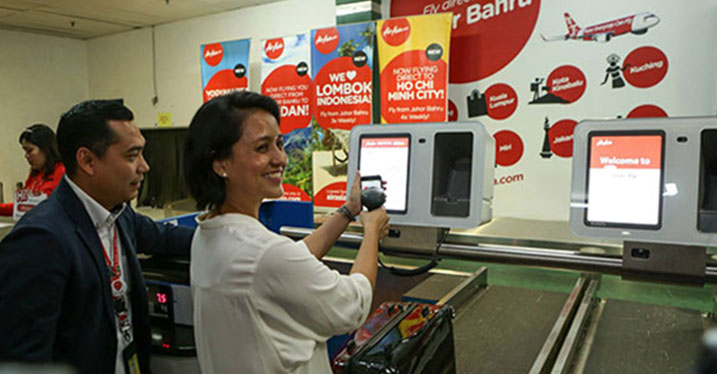
This April AirAsia launched a complete self-service bag drop solution – Scan&Fly from Type22 – at Senai International Airport (Johor Bahru), which became the first airport in AirAsia’s network to deploy the system. AirAsia passengers flying from the airport in the south of Malaysia can now print their bag tags at a check-in kiosk before proceeding to the automated bag drop counter. At the counter they simply have to scan their boarding pass and bag tag using a handheld scanner and if everything is in order and the bag satisfies the carrier’s size and weight criteria, it will be automatically deposited into the baggage handling system.
AirAsia has offered self-tagging at select locations since 2013, but passengers have still had to drop their bag at a manned bag drop counter. The introduction of the new system at Senai International Airport marked the first time AirAsia passengers can complete the entire check-in and bag drop process without any assistance from an airline agent. It only takes up to two minutes and 35 seconds to complete the whole check-in process.
Following the implementation of the bag drop system at Senai International Airport, AirAsia also launched home-printed bag tags on two if its routes. The ‘Home Tag’ service, which allows passengers to print their bag tag at home, is now available to passengers flying between Johor Bahru-Kuching and Johor Bahru-Kuala Lumpur. To make use of this service, passengers just have to print their bag tag on an A4 sheet paper when they print their boarding pass, fold the paper and place it in a provided plastic cover, and attach it to their bag. Upon arrival at the airport, they can then drop the bag at a dedicated bag drop counter.
The carrier has also confirmed that it plans to roll out its fully automated self-service bag drop solution at more locations, including Bangkok’s Don Mueang International Airport, Phuket International Airport, Langkawi International Airport and “a few stations in Indonesia”.
6. Helsinki Airport is first in Europe to install sleeping pods for tired travellers
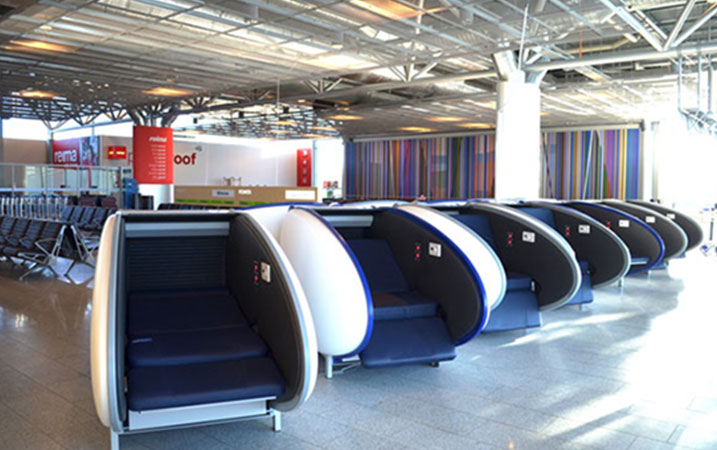
Helsinki makes its second appearance in our Top 10 with the introduction of its sleeping pods, installed back in March to provide transfer passengers with a dedicated space to relax or sleep while they wait for their connecting flight.
The pioneering gateway installed 19 GoSleep pods – ergonomic seats that can be turned into a bed, each with a cover that can be pulled over the pod to isolate the user from the surrounding environment. The pods also have a power point so passengers can charge their electronic device, as well as a space for hand luggage to be stowed. The installation of the pods came two years after Finavia trialled sleeping pods as part of its “rest area” trial at Helsinki Airport. “We wish to provide passengers with an opportunity for stress-free travel and a nap between flights,” said Heikki Koski, Vice President at Finavia. “Helsinki Airport has many transit passengers, who may not have had any sleep for a day or are suffering from jet lag. I believe that the service will have genuine demand.”
5. Aéroports de Paris promotes passenger networking at Orly
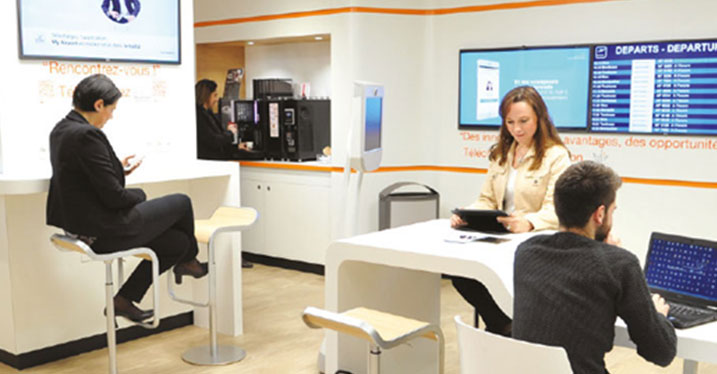
Aéroports de Paris (AdP) unveiled a new digital business lounge concept, Espace business, at Paris Orly Airport in February, providing a space for business travellers to work that makes use of beacon technology to promote networking between passengers.
Espace business is located in Hall 2 of Orly West, where 58% of the 9,000 passengers who pass through the facility on a daily basis are travelling on business. These passengers can now access the new digital lounge free of charge, where they can make use of WiFi and workstations.
Using AdP’s My Airport app, passengers can also register via the ‘Espace business’ tab and give permission for the app to notify other passengers of their presence. Thanks to the installation of beacons in Hall 2, the user will then be automatically notified of anyone else who has registered and is in the vicinity, and they can request a meeting with them if they see potential business benefits. Augustin de Romanet, Aéroports de Paris Chairman & Chief Executive Officer, said: “Air transport is facing changes which expose European airports to an increasing level of competition, between themselves as well as with other means of travel. Aéroports de Paris must therefore continually improve the services it offers by closely following the latest technological developments and ensuring that it meets the needs of all types of travellers. Espace business is in line with the group’s digital strategy to provide passengers with an improved airport experience.”
4. Abu Dhabi Airport implements automated document authentication

Abu Dhabi Airports last month invested in an automated document authentication system that will further enhance its security and expedite processing times at the entrance to the security checkpoint.
When a passenger scans their traditional, mobile or home-printed boarding pass, the new system automatically validate the data, checks it for duplicates and cross-references it against the Airport Operational Database and the airline’s Departure Control System. The information is then displayed to a security agent on a graphical user interface. The system, SITA’s iValidate, includes four security lanes with automatic gates, four mobile/paper boarding pass scanners and four hand-held wireless boarding pass scanners. It will initially be deployed in Terminal 3 economy, followed by the Terminal 3 business area, and will then be implemented in both economy and business areas in Terminal 1.
“Deploying such an advanced technology is a further demonstration of Abu Dhabi Airports’ determination to use the very best the market has to offer. Effectively managing the balance between continuous passenger flow and stringent security measures is a fundamental part of our operations, and the task is even more important in view of our continued growth,” Ahmad Al Haddabi, Chief Operations Officer at Abu Dhabi Airports, said. “With this new technology, verifying passenger documentation will be done quickly and efficiently, while at the same time improving the passenger experience. This is all part of our on-going programme to deliver a smooth flowing airport that affords passengers sufficient comfort and time to enjoy all the facilities on offer.”
3. Iberia, Aena and Siemens partner on new check-in and bag drop solution
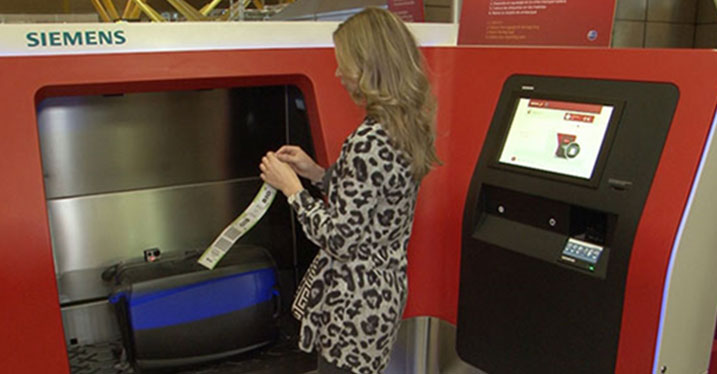
Iberia gave the passenger more independence and sped up the passenger journey when it launched its new service enabling departing passengers to obtain boarding passes and luggage tags and to put their luggage directly onto the conveyor belt without assistance, using a machine next to check-in counters 818-819 in Iberia’s hub at Madrid-Barajas Airport. The new comprehensive self-check-in system was a pilot project developed in collaboration with the airport’s operator Aena Aeropuertos and Siemens.
“This project is the consequence of the magnificent collaboration in recent years by Iberia, AENA and Siemens Postal Parcel and Airport Logistics, resulting in a high-performance system to consistently improve the passenger experience at Adolfo Suárez Madrid-Barajas Airport,” said Nerea Torres, President and CEO, Siemens Solutions for Airports and Logistics in Spain. “This innovative system is a new advance in ‘traveller empowerment’, giving the passenger more autonomy and saving airport waiting time.”
Enrique Robledo, Iberia’s Director in Madrid airport, commented: “With this equipment made by Siemens Solutions for Airports and Logistics in Spain we launch a global project, led by Aena, which will carry on throughout 2015, in which we will test several systems for improving the customer experience during the passenger and luggage check-in process, lending greater autonomy to the passenger who can now complete the process including the delivery of luggage without assistance. This improvement initiative, within the framework of the Ágora Project, is a continuation of the technological innovation and improvement trend driven by Iberia with the aim of making Madrid Airport one of the leading international hubs.”
2. Schiphol switches to central security
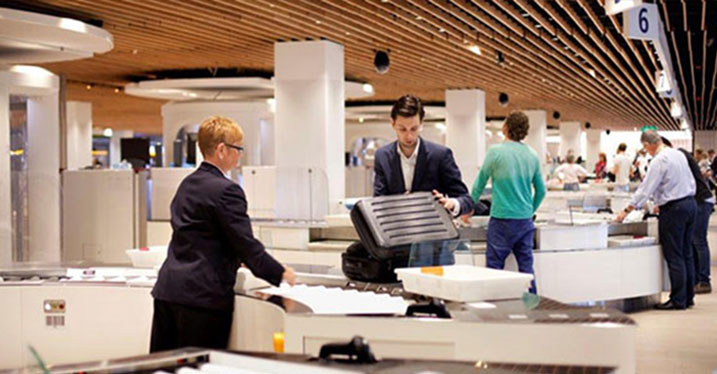
Cementing its position among the world’s most forward-thinking airports, Amsterdam Airport Schiphol now boasts one of the more unique airport security checkpoints. Gone are the slow-moving queues and sterile environment, and in their place is something referred to as the Schiphol Security Experience, which balances efficiency, stringent safety measures and customer experience, essentially delivering what has been labelled “security as a service”. The airport is now using five large central checkpoints in its security processing, meaning the 130 security lanes at its gates are no longer required.
“The transition to central security is a milestone in the renovation of the terminal. It means greater comfort for passengers and a more efficient process for the airlines. A fantastic achievement by all the parties involved, certainly when you consider that we have always remained open during the renovations and will continue to do so,” said Jos Nijhuis, CEO & President of Schiphol Group.
“55 million passengers chose Schiphol last year, and they could all see the renovation work which was being carried out. Renovation is sometimes accompanied by inconvenience, and this could also apply in the months ahead during the completion of the construction work. I would therefore like to thank our passengers, business partners and the airlines for their patience and understanding.” In order to enable the transition to central security, the terminal has undergone a major overhaul. An extra floor was constructed in Departure Halls 2 and 3 to accommodate the new checkpoints. On Piers E, F and G, an additional level was built in order to separate various passenger flows. In total, Schiphol now has three security checkpoints for departing passengers and two for transfer passengers. As well as enhanced comfort and efficiency, the new security concept also anticipates the airport’s future growth, changes in laws and regulations and new technological developments.
1. The ‘Happy Flow’ biometric passenger token project is launched at Aruba Airport
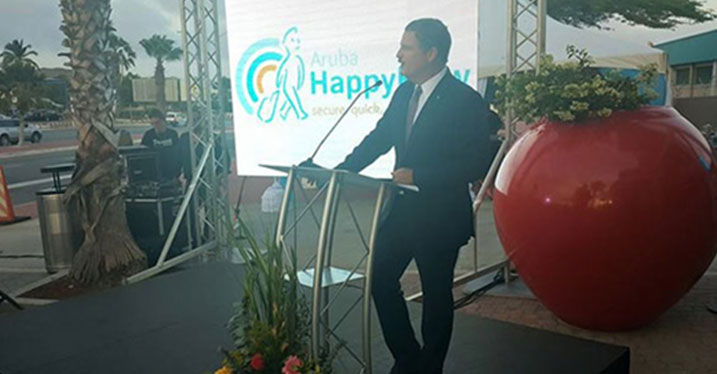
The first of its kind Aruba Happy Flow project – in which biometrics are used as the key identifier at all airport checkpoints – was launched at Aruba Airport in May. The pilot project, which will run for the next two years, will see facial recognition technology used to identify passengers at check-in, bag drop, border control and aircraft boarding. Once the passenger’s passport and facial image have been linked at the initial check-in stage, they will not have to show their passport or boarding pass again before boarding the aircraft.
The project is the result of collaboration between Aruba, the Netherlands, Aruba Airport Authority, Schiphol Group and KLM, while electronic identity solutions specialist Vision-Box has been awarded the tender to implement the project. Aruba’s Prime Minister Mike Eman heralded the launch of the pilot as “an extremely innovative and important step in the transportation industry for passengers, not only for Aruba, but worldwide”.
Initially, a limited number of KLM passengers travelling with an EU passport will be invited to participate in the Happy Flow pilot. Jos Nijhuis, CEO and President of Schiphol Group, which manages Aruba Airport, commented: “With Aruba Happy Flow, together we have made an innovative step to further improve the comfort for the passenger. This is a unique project where amongst others the public and private passenger processes are combined. I have high expectations of the results. If the experience and test results are positive, we will further develop this project.”








Finavia piloting UVC technology to disinfect security control trays after each use
2 comments
London City Airport completes key airfield infrastructure projects
1 comment
View smart windows to be installed in Dallas Fort Worth Airport’s “Gate of the Future”
1 comment
Solar power: the next safe solution for runway lighting?
1 comment